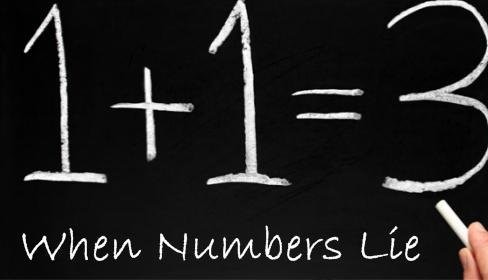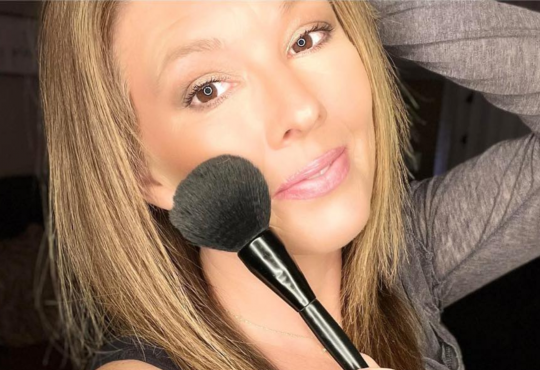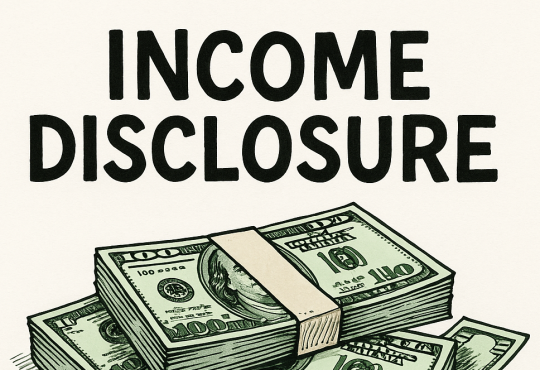
How I Learned Mary Kay Math
 Written by Frosty Rose
Written by Frosty Rose
The highlight of any Mary Kay consultant’s weekly “success event” is the crowning of the queens. Consultants come together to compete, I mean, celebrate each other’s achievements from the previous week. And let me tell you, I dominated those things.
The minimum weekly sales to qualify was $300 because doing that consistently made you a star consultant (an entirely made-up classification based on ordering a bunch of stuff from MK), and it was far more common that I sold $1,000 in a week than that I had to sit out the crowning of the queens due to low sales. I will say, though, it took me a while to get the hang of how to answer their questions during the queen’s interview. Especially my first week, the poor director was completely exasperated by my ignorance.
“How much did you sell last week?” she asked.
“$477.05,” was my answer. You see, I ran a basic expense/income spreadsheet (which I soon learned was completely abnormal), so I knew my numbers to the penny.
“Oh, no, I mean, how much retail product did you move off your shelf?” she asked sweetly.
“Um… I didn’t calculate that. Let me look… Let’s see, I sold $52 for full price, sold two roll-up bags for $398 and included $150 in free product to get that upsell, gave my hostess $120 hostess credit, so that makes $720.”
“Wow, that’s amazing! And in your first week of the business, too!”
“I know, my mom hosted a great party with her friends,” I answered.
“So how much was your profit from that party?” was the obvious next question, for the benefit of the guests in the room.
“$73.80 was my profit,” I answered, that spreadsheet in all its black-and-white glory still in my hand. “But I put $50 of that back on the credit card to pay off my inventory and kept the other $24 as play money.”
“No, no, no. The profit from $720 in retail sales is $360,” she answered, as though explaining to a kindergartner that 2+2=26. “And we don’t have to talk about how you spent it.”
“But that doesn’t factor in discounts, products I gave away, and expenses. Or paying for my inventory,” I responded, naively.
“That’s not how we calculate your profit for weekly success events.”
I really wanted that stupid plastic tiara, so I went with it. The next exchange was predictable to anyone who had attended more than three of these meetings.
“Ok, so the next question, how much did you earn per hour with this fantastic week?” she asked, a bit more warily this time, given my inability to figure out the simplest Mary Kay math.
“Oh, I didn’t calculate that, either. Um, let me see… About $18.50 per hour,” I answered.
“You worked 20 hours on just one party?!? That’s not possible,” exclaimed the confused director.
“No, like I said, my profit was just under $74. I worked about four hours.”
“Again, we said your profit was $360. And four hours is still too high for one party. Maybe we need to talk about your training.”
“Oh, it only took about two hours for the party. But I spent 30 minutes calling all the guests beforehand to make sure I was prepared. Then another 15 minutes writing thank you notes. And 45 minutes booking for next week. Plus, about half an hour doing bookkeeping and stuff.”
“Frosty Rose, we only count the hours you spent at the party as hours worked. So you profited $360 on your $720 week, and it took you two hours to sell all that product. You earned $180 per hour of work! That’s an awesome first week! If you had been working your Mary Kay business full time, that would have been $7,200 on income in just one week!” And from there, she shooed me back to my seat, tiara firmly on my head, clearly at a loss for what to do with me.
I did eventually learn Mary Kay math and justified the mental gymnastics of it because I wanted to win. Mary Kay often draws women with a peculiar combination of low self-esteem and a high drive to achieve and receive recognition for that achievement. Many of us would say whatever we had to say to win, both in front of other consultants and to our customers.
I kept my trusty spreadsheet, so I knew my real profit, and I did make decent part-time money that first year. After the first twelve months, though, I got sucked into all the events. Seminar my first year cost over $1,000. With Mary Kay math, that number is justifiable with my high party sales—after all, that’s just three parties. But, as we’ve seen, that profit number is grossly inflated. With real-world math, it took 14 parties, or seven weeks of work (at two parties per week), just to pay for seminar. That’s a tougher pill to swallow.
For those struggling to keep up with the Mary Kay math, I’ll break down the simple rules I learned about calculating sales, especially for weekly recognition purposes:
- How much you sold has nothing to do with how much your customers paid you. It has everything to do with the retail value of the products that left your shelf. Gave them away? Count it as full price. Ran a special for your loyal customers and heavily discounted everything that week? Count it as full price. Included discontinued products as gifts with purchase? It all counts as retail sales.
- Never factor in your business expenses when you calculate profit. Your profit is always 50% of the retail value of the product that left your shelves. No need to complicate things.
- Only count face-to-face time as “working” time when calculating how much you earned per hour. It doesn’t matter if you spent 10 hours in your office making calls, tracking inventory, and doing bookkeeping. You only worked three hours last week because that’s all the time you spent at your one party.
- Profit-per-hour should always be extrapolated out based on a 40-hour workweek to encourage prospects/new consultants to quit their full-time job. It doesn’t matter if a consultant only sold $100. If it took her 15 minutes to do that, her profit-per-hour was $200 and she was the queen! She can’t pay her bills, even with that fictitious $50 profit, but yay her! Her only mistake is staying at that soul-sucking J.O.B. (spelled out like it’s a cuss word) earning just $20 per hour.
- Discussing credit card balances or paying off inventory is completely off-limits. All that stuff just magicked its way into your office without any need for paying exorbitant interest on the financing or making any other questionable financial decisions to get it there.





 Visit the
Visit the
Retail wholesale, retail wholesale, part of the con is to mix and match these two ideas when you are pushed to be very busy and order order order. The lines blur on purpose, and as an engineer nothing added up but hey they are on the the next!!!!! Next!!!!! Wholesale ideas or was it retail? I forget. Amazing math when you are supposed to own your business.
We engineers not too sanguine about questionable math. In our profession, if things don’t add up, people could get hurt. Or worse.
*are not too sanguine. (Here’s hoping my math is better than my proofreading.)
…and now we know the true story behind Pink Truth critics who write in to say “I made $2,000 my first month, so there!”
Imagine my Director’s horror when I showed up at our weekly meeting (in her home) to share my spreadsheet that calculated sales down to the penny. I had determined that I could not purchase additional inventory until my spreadsheet showed funds in that column were sufficient enough to fully pay for what I wanted to order from MK. I had columns for EVERYTHING imaginable! Cost of goods, discounts, postage, shipping, credit card payoff, conferences and events, section 2 costs, payment to me as income, sales tax, and the final column was repurchase funds.
None of us had ever had any discussion about how to track anything! This spreadsheet cross-calculated everything on its own. Her face turned white as I proudly explained how this helps you run a real business!
She quickly shut the conversation down and asked that I not share that with the others as she would now set up time time individually to show them how MK wants us to keep records. Thanks so much for sharing!
I lasted only a short time after that. The spreadsheet did not lie! No way to make money here if you treated the business like a business.
MK probably wanted you to keep records on pink scented stationery with a crayon, and instead of numbers just draw little hearts and stars. It’s all so backwards from how the real world works.
You don’t know how right you are! (And I was never in MK.) But I’ve seen enough juvenile “tracking sheets” that had you coloring in piece-parts of the Red Jacket, filling in bubbles, or crossing off lipsticks on a sheet of paper.
I did the same thing! It’s why I lasted all of 7 or so years. I tracked it all and didn’t order unless I had the funds. Let me tell you…I was not in the communication loop with my SD/NSD since I didn’t order based on their begging call. Even then, at best I only profited minim wage or less.
I dwindled out because I hated the constant need of to warm stalk. And, I hated the continued calling of my customers asking if they needed a new mascara.
“Even then, at best I only profited minim wage or less.”
That’s great proof about mk doesn’t work if you do it with business sense. Thank you for sharing this.
“Even then, at best I only profited minim wage or less.”
That’s great proof about mk doesn’t work if you do it with business sense. Thank you for sharing this.
does the FTC ever catch wind of these completely bogus income claims?
Yes, they do!
https://www.ftc.gov/news-events/news/press-releases/2022/02/ftc-takes-action-combat-bogus-money-making-claims-used-lure-people-dead-end-debt-traps
I recently saw a post by a MK director that said:
“It only takes $27.40 of spending a day to blow $10,000 a year.
This also means you only need to make $27.40 a day to earn an extra $10,000 a year.
This is your WHY to start a side hustle.”
It seems so simple until you do the math. Assuming 40% profit on sales (being generous), you need to NET $191.80 a week or sell $479.50 a week. We all know how easy that is to do consistently every week! As directors, how many of you even had consultants that had consistent $300 weeks?